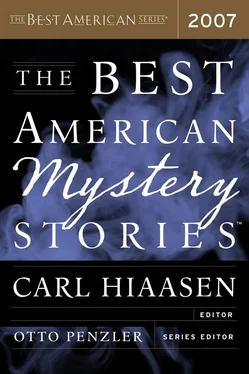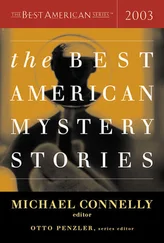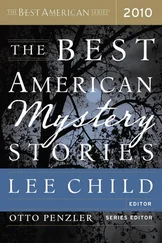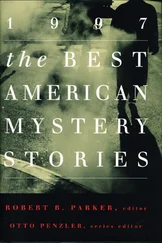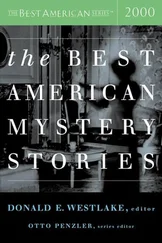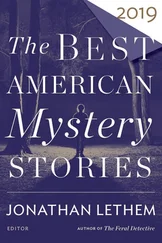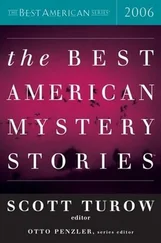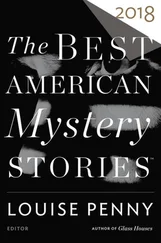Robert Andrewsis a former Green Beret and CIA officer whose first four novels dealt with the spy business. His last three novels, however (Marian Wood, G.P. Putnam’s Sons), feature homicide detective Frank Kearney and Jose Phelps. Andrews and his wife BJ live in Washington, D.C.
• I was noodling around, thinking about a plot for a fifth spy novel, when Chuck and I had lunch. Chuck was one of the Washington Posts best investigative reporters. An acolyte of Bob Woodward, Chuck specialized in prying the tops off well-guarded cans of worms Washington’s political elite hoped to hide from their constituents.
“Story on the wire,” Chuck tells me one day at Stoney’s. “Hit-run kills a Catholic priest in Boston. He’s got eighty thousand bucks... cash... in shoeboxes in his closet.”
Chuck smiled. “They trace it to a Brinks holdup.”
The Soviet Union had gone belly-up almost ten years before. And terrorists hadn’t yet driven into the Trade Center. BJ and I had just moved into D.C. from a quiet Arlington, Virginia, neighborhood. That year, the district earned the honor of becoming the nation’s murder capital.
And so my first crime novel, A Murder of Honor: A drive-by shooting, and Father Robert J. O’Brien sprawls dead on Pennsylvania Avenue. The more detectives Kearney and Phelps work the case, the more fingers point to the good priest’s involvement in a nasty drug operation. At the same time, more comes out that paints O’Brien as a man of honor.
Martha Mitchell, wife of Nixon’s attorney general, described Washington as “too small to be a state, too big to be an insane asylum.” In writing A Murder of Honor and its sequels, I realized that Washington’s swamp-fever looniness offered more permutations for intrigue and mischief than did international espionage.
And so Kearney and Phelps show up in the draft of the fourth D.C. cop novel: On the same morning that an advertising executive kills himself in the upper-class Northwest, a student in ragged Anacostia murders a beloved high-school teacher. And there’s a connection... some three hundred pages from now.
Back to “Solomon’s Alley”: Kearney and Phelps have cameos. But the protagonist is Solomon, who tends to his Georgetown alley and argues with his Voices.
Peter Blauneris the author of six novels, including Slow Motion Riot, which won the 1992 Edgar Award for best first novel of the year, and The Intruder, a New York Times bestseller as well as an international bestseller. His most recent novel is Slipping into Darkness. He lives in Brooklyn, New York, with his wife, author Peg Tyre, and their two children.
• I have only one firm rule about writing: Don’t do it about the kids. Any so-called grownups I run into are fair game; I tell them I’m a writer and they take their chances when they talk to me. Children don’t have that choice. Still. “Going. Going, Gone” might be an indirect tribute to the fact that they sometimes understand the world around them better than the adults who are supposed to be looking after them. The story was also intended as an homage to Morris Engel’s wonderful 1953 film, Tittle Fugitive — a seminal influence on New Wave directors like François Truffaut and John Cassavetes. Not that many people have seen it, though it used to pop up occasionally on the late, late movie back in the sixties and seventies. It’s about a little kid who runs away to Coney Island after he thinks he’s killed his older brother. Though my story obviously goes in a different direction, it’s a debt I’ve been meaning to make good on. So I’m glad for the opportunity to settle up here.
Lawrence Blockis a devout New Yorker and enthusiastic world traveler. He has won Life Achievement awards from writers’ organizations here and abroad, and characterizes them as “a way for your colleagues to tell you that your future lies largely in the past.” Like Keller, he’s a passionate philatelist; unlike any of his heroes, he’s an apparently deranged participant in marathons and ultramarathons.
• Keller first saw the light of day in a short story, and the three books about him (Hit Man, Hit List, and Hit Parade) are either short-story collections or episodic novels, as you prefer. The guy seems to be a true guilty pleasure for readers, who tell me they don’t want to like him, but they can’t help themselves. This particular story came about because an editor wanted something for a collection of basketball stories; I told him I couldn’t think of anything, and then, curiously, I thought of something.
John Bondis a raconteur living in Dania Beach, Florida. A licensed pilot and boat captain, he has been a lawyer, realtor, adjunct professor of journalism and creative writing, tour group leader, scuba instructor, columnist, newspaper editor, political campaign manager, lobbyist, developer, and more. He is the coauthor (with Roy Cooke) of six books about poker, including 2007’s Home Poker Handbook. His day job is to love his wife, Jeannie, who is too good for him.
• I’m still trying to explain to both my wife and mother why I gave up practicing law to write and play poker. And that poker really isn’t gambling. Some fifteen years later they remain skeptical.
I am a true newbie in the short-story world. “T-bird,” from the anthology Miami Noir, is not only my first published fiction, it is the first short story I have ever submitted anywhere. I have some 5,000 pages of unfinished novels, failed screenplays, character sketches, and plot notes. But no short stories.
I got lucky when I quit lawyering that Florida International University’s Creative Writing Program was just a few miles from my home. It’s a small program counting among its alumni the likes of Dennis Lehane and Barbara Packer, and lesser-known but stellar writers like Vicki Hendricks, Sandra Rodriguez Barron, and Christine Kling. Thanks eternally to the FIU faculty: Les Sandiford (Miami Noir editor), John Dufresne (also represented in this anthology), Lynne Barrett (Edgar winner), Campbell McGrath (Guggenheim genius grant winner), and Jim Hall (kick-ass thriller writer) for molding me into something of a writer. To the extent my work has any merit I owe it to them; to the extent I suck that’s my own damn fault.
Writing a short story, especially one with defined themes (Miami and Noir) is something like writing a sonnet. Form can dictate content, force you to be creative in ways you would not normally have considered. When I think Noir, I think night, I think betrayal, I think lust trampling over reason. My femme fatale Rebel is surnamed O’Shaunessy, a tip of the hat to Hammett’s Maltese Falcon, which for me epitomizes Noir. And then there’s the delightful irony of setting darkness amid the palms and banyans in the sun-dappled tropical paradise, perfected by the editor of this collection, Carl Hiaasen. The form indeed dictated much of the story.
I used to run a game like McKool’s — the statute of limitations has run, so I can admit it. I loved how the day and night worlds collided there, the incredible variety of people one meets at the poker table. It seemed a suitable place to set something dark. It was there I met a girl who ran a scam not unlike that described in the story, though rather than die at the end she hit pay dirt.
My FIU mentors say I should take another shot at the short story. As their advice so far has been nothing but dead-on right, I may just do that.
James Lee Burkewas born in 1936 in Houston, Texas, and grew up on the Louisiana-Texas coast. He attended Southwestern Louisiana Institute (now called the University of Louisiana at Lafayette) and later the University of Missouri at Columbia, where he received a B.A. and an M.A. in English literature.
Читать дальше
